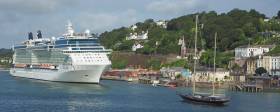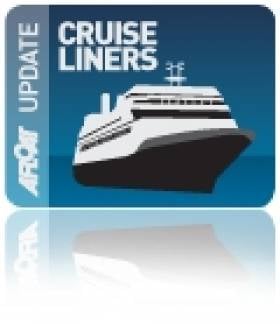Displaying items by tag: Larger Cruiseships
Cork's Cruiseship Bonanza: 200,000 People Expected This Year
#Cruiseliners - The Port of Cork is braced for a cruise bonanza in 2018, with some 200,000 people due to arrive on cruiseships to Cobh, Ringaskiddy and the city centre this year.
The long-term outlook is even more promising reports the Evening Echo, with officials at the Port of Cork confirming that early bookings for 2019 have already exceeded last year's total arrivals.
The first cruiseship is due to arrive in Cobh in mid-March, with 95 liners set to dock before the season ends on December 20.
Captain Michael McCarthy, commercial manager at the Port of Cork, said that the outlook for the year is 'very promising.'
"Last year, we had 67 bookings. This year, it is closer to 100. We are up about 30-35%," he said.
"The long-term outlook is good, too. 2019 is already looking even better. We are only part of the way through booking in liners and we have already exceeded the total for last year."
Mr McCarthy expects 150,000 passengers and an additional 50,000 crew to arrive at Cobh, Ringaskiddy and Custom House Quay over the coming year. This is an increase from 2017 when 100,000 passengers and 43,000 crew visited the region.
The increase in traffic is largely driven by an increase in bigger vessels visiting, Mr McCarthy added.
For more scroll down the newspaper's page here, beyond the photo of cruiseship Independence of the Seas, which Afloat adds made its first call to Cobh over a decade ago in 2007.
Bid to Cater for Even Larger Cruiseships to Cobh
#LargerCruiseships - Planning permission is been sought by the Port of Cork for a €1.5m deep-water pontoon and access bridge to cater for bigger cruise liners arriving in Cobh, writes the Irish Examiner.
The port authority has applied to Cork County Council for the facility, which it hopes to have completed by next April — the start of the annual cruiseseason.
Port of Cork commercial manager captain Michael McCarthy said it was imperative that it built facilities to handle the new generation of cruise liners.
"The current berth can handle ships like Celebrity Eclipse and Independence of the Seas, which are up to 330-340 metres in length. The next generation, such as the Quantum of the Seas (167,000 tonnes), will be longer and will carry nearly 4,000 passengers," he said.
This year the biggest vessel visiting the port will be the Royal Princess (141,000 tonnes) as previously reported on Afloat.ie, which arrives in Cobh next month. The Irish Examiner has more on the planning permission story, click HERE.
Afloat.ie adds three cruiseships are to call this Thursday, the trio are Sea Cloud II (2001/3,849grt) MSC Magnifica (2010/92,128grt) and Aidacara (1996/38,557grt). To find out further details of each visiting vessel, click to our coverage link above.






























































